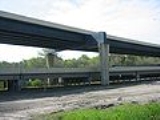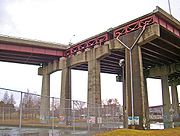
Girder bridge
Encyclopedia
A girder bridge, in general, is a bridge
built of girder
s placed on bridge abutments and foundation piers. In turn, a bridge deck is built on top of the girders in order to carry traffic. There are several different subtypes of girder bridges:

Bridge
A bridge is a structure built to span physical obstacles such as a body of water, valley, or road, for the purpose of providing passage over the obstacle...
built of girder
Girder
A girder is a support beam used in construction. Girders often have an I-beam cross section for strength, but may also have a box shape, Z shape or other forms. Girder is the term used to denote the main horizontal support of a structure which supports smaller beams...
s placed on bridge abutments and foundation piers. In turn, a bridge deck is built on top of the girders in order to carry traffic. There are several different subtypes of girder bridges:

- A rolled steel girder bridge is made of -beamsI-beam-beams, also known as H-beams, W-beams , rolled steel joist , or double-T are beams with an - or H-shaped cross-section. The horizontal elements of the "" are flanges, while the vertical element is the web...
that are rolled into that shape at a steel millSteel millA steel mill or steelworks is an industrial plant for the manufacture of steel.Steel is an alloy of iron and carbon. It is produced in a two-stage process. First, iron ore is reduced or smelted with coke and limestone in a blast furnace, producing molten iron which is either cast into pig iron or...
. These are useful for spans between 10 metres and 29.5 metres (33 feet to 100 feet). Rolled steel girders are practically available with a web height of up to one metre (3 feet). - A plate girder bridgePlate girder bridgeA plate girder bridge is a bridge supported by two or more plate girders. The plate girders are typically I-beams made up from separate structural steel plates , which are welded or, in older bridges, bolted or riveted together to form the vertical web and horizontal flanges of the beam...
is made out of (mostly) flat steel sections that are later welded or otherwise fabricated into an -beam shape. Plate girders can have a greater height than rolled steel girders. Plate girder spans can be used for spans between 10 metres and more than 100 metres (33 feet to more than 330 feet). The web (vertical section) of a plate girder can be taller than that of a rolled steel girder, providing greater strength than a rolled steel girder. The thickness of the top and bottom flanges of a plate girder does not have to be constant; the thickness can be changed (typically at a field splice) to save on material costs. Stiffeners are occasionally welded between the compression flange and the web to increase the strength of the girder. - A concrete girder bridge is made of concrete girders, again in an -beam shape. The concrete girders can be either prestressed cast concrete or post-tensioned girders. Concrete girder bridges are best for spans between 10 metres and 50 metres (33 feet to 164 feet). Prestressed, precast concrete girders are readily available.
- A box girder bridgeBox girder bridgeA box girder bridge is a bridge in which the main beams comprise girders in the shape of a hollow box. The box girder normally comprises either prestressed concrete, structural steel, or a composite of steel and reinforced concrete. The box is typically rectangular or trapezoidal in cross-section...
is built from girders in a rectangular box shape instead of an -beam shape. - An -beam bridge is simple to design and build, and works well for straight spans. However, if the bridge needs to be curved, the beams are subject to twisting forces (torque). This can be alleviated by building several shorter, straight spans with a curved bridge deck, or by using box girders. Building metal box girders is more difficult, though, because the welding of the inner corners between the flanges and the webs has to be done either by a robot or a human, depending on which can fit inside.
External links
- Structural Systems and Dimensions (PDF) - Montana Department of Transportation
- Structural Steel Superstructures (PDF) - Montana Department of Transportation
- Bridge Types - Girder

